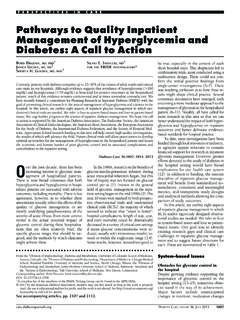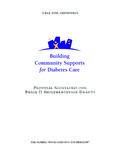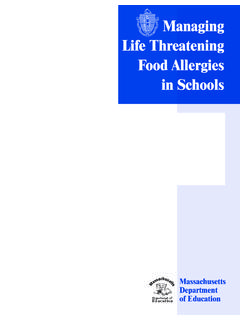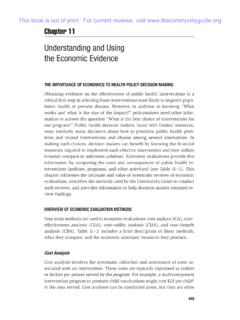Transcription of Management of Hyperglycemia in the Hospital Setting
1 Clinical pr acticeThe new england journal of medicinen engl j med 355;18 november 2, 20061903 Management of Hyperglycemia in the Hospital SettingSilvio E. Inzucchi, the Section of Endocrinology, Yale University School of Medicine, New Haven, CT. Address reprint requests to Dr. Inzucchi at the Section of Endocrinology, Yale University School of Medicine, 333 Cedar St., LLCI-101, New Haven, CT 06520-8020, or at Engl J Med 2006;355 2006 Massachusetts Medical 53-year-old woman with asthma and multilobar pneumonia is admitted with respi-ratory failure. She is intubated and treated with antibiotics, albuterol, and methyl-prednisolone.
2 A random blood glucose measurement obtained on admission shows a level of 183 mg per deciliter ( mmol per liter). After 3 hours in the intensive care unit, she has a capillary glucose level of 264 mg per deciliter ( mmol per liter). She has no history of diabetes. Should her Hyperglycemia be treated, and if so, how?The Clinical ProblemUntil recently, Hyperglycemia in hospitalized patients was considered to be little more than a paraphenomenon of illness. However, evidence that in certain circumstanc-es aggressive therapy may improve clinical outcomes has brought increased atten-tion to glucose Management in the inpatient relationship between Hyperglycemia and acute illness is a complex ,3,4 Hyperglycemia is frequently encountered during hospitalization owing to increases in patients circulating concentrations of stress hormones.
3 In experimental models, severe Hyperglycemia (generally characterized as a glucose level greater than about 250 mg per deciliter [ mmol per liter]) has been shown to have deleterious effects on the vascular, hemodynamic, and immune systems (Fig. 1).1,3,4 Several retrospec-tive studies have shown that Hyperglycemia is associated with poor outcomes in hos-pitalized patients. Postoperative glucose levels are a significant predictor of infection rates after cardiac ,6 In a study of patients with diabetes and acute myocar-dial infarction, elevated levels of blood glucose at the time of admission predicted both in- Hospital and 1-year Similar findings have been reported for patients in medical intensive care units (ICUs),8 general postsurgical patients,9 and patients with other acute cardiovascular events, including stroke10-12.
4 Associations between glycemia and the risk of death remain significant even after adjusting for the se-verity of These observations are not confined to patients with In one study, in- Hospital mortality rates appeared to be even higher for patients with newly diag-nosed Hyperglycemia than for those with overt Such data, although pro-vocative, cannot prove cause and effect; the question of whether glucose is a modi-fiable mediator of adverse outcomes or simply an innocent marker of critical illness remains unanswered. If glucose is in fact a mediator, aggressive therapy may be indi-cated.
5 Clearly, intensive insulin administration and the need to monitor the patient come at a cost of time and money. Such therapy may also predispose patients to hypoglycemia, with attendant risks of transient or, in rare cases, permanent compli-cations. What is the evidence that tight glucose control during hospitalization im-proves outcomes?This Journal feature begins with a case vignette highlighting a common clinical problem. Evidence supporting various strategies is then presented, followed by a review of formal guidelines, when they exist. The article ends with the author s clinical recommendations.
6 Copyright 2006 Massachusetts Medical Society. All rights reserved. Downloaded from by JAMES KRINSLEY MD on November 13, 2006 . The new england journal of medicinen engl j med 355;18 november 2, 20061904 Strategies and EvidenceSeveral studies have assessed the benefits of ag-gressive glucose control in the critical care Setting , but they have involved markedly different patient populations (patients with and those without dia-betes), study designs, glucose targets, and insulin strategies. Moreover, their results have not been uniformly an observational study involving 1499 pa-tients with diabetes in a cardiothoracic ICU, the use of an insulin infusion protocol to lower glu-cose levels to 150 to 200 mg per deciliter ( to mmol per liter) in the 24 hours after open heart surgery, as compared with the use of con-ventional insulin sliding scales in historical con-trols, was associated with a significant reduction in the incidence of deep sternal wound infection ( vs.)
7 The lack of randomization makes these results difficult to interpret, however, since other improvements in care had probably occurred since the period when the controls were treated. However, similar results have been reported in smaller randomized14 and nonrandomized15 stud-ies of glucose control after cardiac Diabetes Insulin Glucose Infusion in Acute Myocardial Infarction (DIGAMI) Study randomly assigned 620 patients with diabetes and acute myocardial infarction to intensive or conventional glucose Management both in the Hospital and for 3 months after Intensive Management the use of an insulin infusion for at least the first 24 hours of hospitalization to reduce glucose levels to 126 to 196 mg per deciliter ( to mmol per liter)
8 , followed by multiple daily injec-tions resulted in a mean glucose level at 24 hours of 173 mg per deciliter ( mmol per liter), as compared with 211 mg per deciliter ( mmol per liter) among patients assigned to conventional glucose control (P< ). In the group receiving intensive Management , the 1-year mortality rate was 29% lower than that in the group receiving conventional glucose control ( vs. , P = ) and remained significantly lower at 5 Because of the study s design, however, it is not known whether the inpatient or outpa-tient intervention was responsible for the risk re-duction.
9 The DIGAMI-2 Study attempted to address this issue by randomly assigning 1253 patients with diabetes to one of three treatments after acute myocardial infarction: aggressive inpatient treatment (insulin infusion; target glucose level, 126 to 180 mg per deciliter [ to mmol per liter]) and outpatient treatment, aggressive inpa-tient treatment only, or conventional care There were no significant differences in the rates of death or complications among the groups, but the study was statistically underpowered, and there was ultimately little difference in their mean glucose levels. Consequently, little can be con-cluded from this report or from another similarly flawed Studies involving glucose, insulin, and potassi-um (GIK) infusions have also had conf licting These investigations did not target glucose levels but instead assessed the potential benefit of insulin infusion itself during or immediately after acute myocardial infarction.
10 In the largest of these studies,21 involving more than 20,000 patients, GIK infusions had no benefit; however, the glu-cose levels in the treatment group were actually higher than those in the control , there is some rigorous evidence that tight glycemic control in the ICU Setting is beneficial. A randomized trial of 1548 intubated patients in the surgical ICU (13% with an estab-lished diagnosis of diabetes) compared aggressive treatment with an insulin infusion (target glucose Decreased immune functionDecreased wound healingIncreased oxidative stressEndothelial dysfunctionIncrease in inflammatoryfactorsProcoagulant stateIncreased mitogen levelsFluid shiftsElectrolyte fluxesPotential exacerbation of myocardial and cerebralischemiaIncreased stress hormone levelsIncreased epinephrineIncreased cortisolGlucocorticoid therapyContinuous enteral nutritionParenteral nutritionDecreased level of activityAcute illnessHyperglycemiaFigure 1.)








